Maintenance technology for long-span bridges (related to superstructures)
Dry air injection system for suspension bridge cables
The main cable is an important member in the component of a suspension bridge.
Among the Honshu-Shikoku Bridges, the Innoshima Bridge, Ohnaruto Bridge, Ohshima Bridge, and Seto-Ohashi Bridge were completed early times. Their cables are composed of densely bundled steel wires with zinc plating. Their surface was coated with a rust inhibitor, and was protected by spirally wound zinc-plated steel wires and a further coating to protect them from rust
For study on rust-proofing method for the main cable for the Akashi-Kaikyo Bridge, an investigation of the main cables of existing suspension bridges with removing of the spirally wound zinc-plated steel wires, were conducted. As the results, rust was found on the surface of the steel wires that compose the main cables.
Therefore, we examined rust-proofing methods for main cables and developed and installed the world's first dry air injection system as a countermeasure to remove the cause of rust by drying the inside of the main cable. In this method, we set our management target value (40%) on the safe side of the humidity limit at which corrosion occurs (60%), and installed it to all suspension bridges among the Honshu-Shikoku Bridges.
Currently, to achieve efficient operation of dry air production equipment, we are installed the additional pre-cooler equipment to lower humidity of high humid air in times such as the summer season.
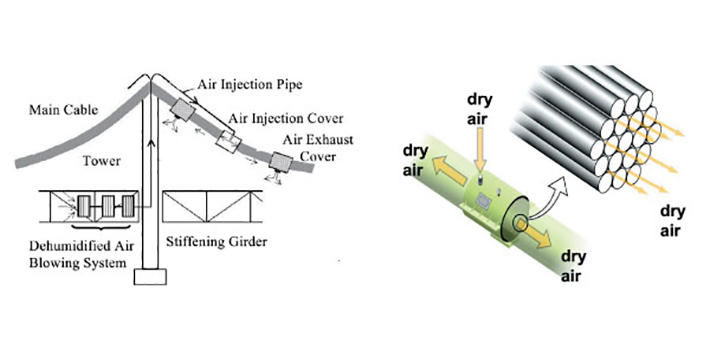
Suspension bridge hanger rope non-destructive inspection technology
The hanger ropes of suspension bridges are important members that hang stiffening girders from the main cable. Among hanger ropes, there are some that use steel strand ropes with painting.
Since it is difficult to economically remove and investigate the hanger ropes one by one to check the insides of the ropes for corrosion, we have started developing a non-destructive inspection method to get an understanding of the amount of corrosion in the hanger rope without removing and opening them up.
As a result, it was realized that it is possible to apply a method called the Total Magnetic Flux Method for inspection. In the Total Magnetic Flux Method, we strongly magnetize the hanger rope, measure the magnetic flux (the number of lines of magnetic force passing through a rope's cross section) in the hanger rope, and estimate the decrease in cross section area due to corrosion by using the proportion of the magnetic flux to the cross sectional area. Since the corroded steel material becomes nonmagnetic, it is possible to determine the location and amount of corrosion in the rope.
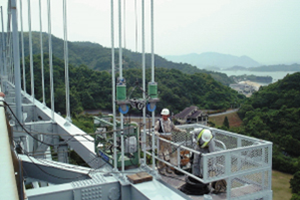
Non-destructive hanger rope inspection via the Total Magnetic Flux Method
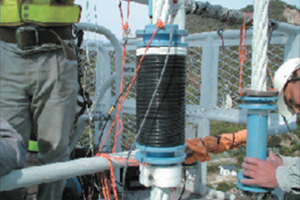
Measurement
Suspension bridge hanger rope vibration control countermeasure technology (1)
For the Kurushima-Kaikyo Bridges' hanger ropes, instead of the hanger ropes in the shape of ropes hung over a cable bande (called CFRC) used in bridges such as the Innoshima Bridge and the Seto-Ohashi Bridges, taking into consideration of maintenanc , we used polyethylene-overlaid ropes with pin anchorage (PWS).
However, because wind vibration was confirmed in hanger ropes with 30 meters or more in length from when the stiffening girder hanging was completed, we investigated hanger rope vibration control countermeasures. As a result, we decided to counteract wind vibration using vibration control devices. For the vibration damping material, we use an elastic sealing material which was expected to have a vibration-controlling effect at low cost, and currently the vibration control devices have a sufficient vibration-controlling effect.
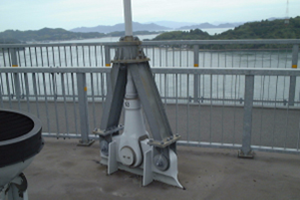
Hanger rope vibration control devices
Suspension bridge hanger rope vibration control countermeasure technology (2)
Because there are some long hanger ropes of the Akashi-Kaikyo Bridge that exceed 200 meters, and the numbers of ropes are also numerous, considering economy and easeness of maintenance, we made a structure with 2 hanger ropes overlaid with polyethylene tubes, "parallel-wire cable strands" (installed in parallel for each panel point), which are both stronger and more resistant to corrosion than previously-used wires.
At the Akashi-Kaikyo Bridge, we confirmed the phenomenon that the leeward cable of parallel hanger ropes experiences a large amount of vibration during strong winds of about 20 meters per second due to typhoons or so. Previously, it was thought that this kind of vibration would only occur in conditions when the relationship of the hanger rope's diameter, D, to their pitch, L, was L<5D, and therefore it would not occur in the case of this bridge (L=9D).
Therefore, we conducted wind tunnel tests to investigate in detail the conditions in which this kind of vibration occurs, its vibration characteristics, and methods of vibration control. As a result, it was confirmed that a vibration control effect can be obtained by winding a wire with diameter of 10 millimeters around the hanger rope in a spiral shape. We also developed a wire winding machine and wound wire on the hanger rope of this bridge.
At present, we have not confirmed the presence of any harmful vibrations in strong winds during typhoons or so.
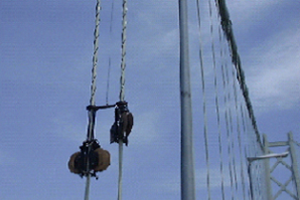
Suspension bridge hanger rope vibration control countermeasure construction
Anti-vibration countermeasures for cables of cable-stayed bridge
The cables of the Tatara Bridge are extremely long and they had a remarkably small vibration frequency compared to previously-constructed cable-stayed bridges.
And it was considered that vibrations that occur due to wind and rain and called rain-induced vibrations, were a problem.
A large-scale devices (dampers) were required to forcibly suppress these vibrations. Therefore, we developed and adopted an aerodynamic vibration control method by using an indented cable type with discrete and concavities on the cable surface.
Also, as a vibration control countermeasure for vortex excitation, elastic seal material was installed on the cable’s girder-side anchorage zone to suppress vibrations.
At present, we have been monitoring the vibration of cables in the wind and have not confirmed any harmful vibrations.
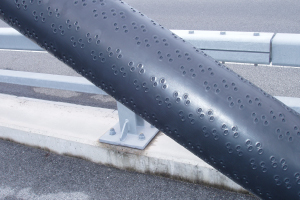
Indented cable
Dry air injection system for steel box girder
As a material for bridge-building, steel has excellent characteristics that are not found in other materials such as its strength, lightness, ease of processing, but its disadvantage is its susceptibility to corrosion.
As a rust-prevention countermeasure for the inner surfaces of long-span bridge box girders, we normally coat the surfaces of steel materials in 3 layers of paint, but for the Shin-Onomichi Bridge, we did not paint the inner surfaces of the box girders, but instead use an dry air injection system to maintain a humidity level inside the girders at which the steel will not corrode. The purpose of this was to decrease the initial investment and the cost of repainting by eliminating the paint needed for girders' inner surfaces, which have approximately 4 times the surface area of girders' outer surfaces.
The dry air injection system makes dry air circulate through the steel deck u-ribs, as pipes for the air supply, by placing an dry air injection equipments inside the box girders, thus maintaining a level of relative humidity of 60% or less inside the box girders.
There are tested instances of this dry air injection system for bridges in Japan. But this bridge is the first in Japan in which it is being practically applied.
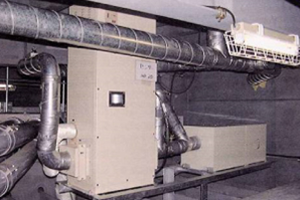
Dry air injection equipment
Repainting
The majority of the long-span bridges over straits are made of steel, and what is most important to preserving their function over the long term is rust prevention. Therefore, the most fundamental maintenance management for the Honshu-Shikoku Bridges is that of paint.
Paint deteriorates due to ultraviolet rays and moisture, so regular repainting is necessary. The Honshu-Shikoku Bridges have about 4 million square meters of painted surface.
Because in the future, as painting costs increase as the paint deteriorates with the passing of time, painting will occupy approximately half of maintenance costs, the most important method of minimizing the life cycle cost of the Honshu-Shikoku Bridges is to decrease the cost spent on painting.
For this reason, in order to lengthen the repainting cycle, during the construction stage we have developed a painting system with a multi-layered structure which can be expected to have long-term durability. Even in the maintenance management stage, we developed highly durable paint resistant to ultraviolet rays and used it for the repainting of the Seto-Ohashi Bridge.
We make decisions on the optimal timing for repainting by regularly investigating how much the paint coating thickness at certain fixed points has decreased and making estimates of how far deterioration has progressed.
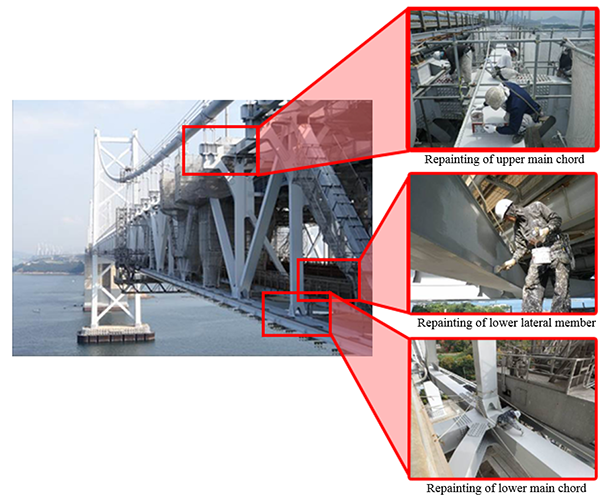
Suspension bridge hanger rope repair technology
In the hanger ropes of the Innoshima Bridge that use steel strands, there is not only deterioration of the coating paint, but there is also internal corrosion of the ropes which is thought to be caused by rainwater penetrating and remaining inside them. Therefore, for repainting the hanger ropes, we adopt an "immersion painting method", which is a method of dipping the hanger in paint so that the paint fills in the rope's interior.
On the other hand, for the Ohnaruto Bridge, which is in a particularly harsh corrosive environment, there was a remarkable amount of corrosion confirmed in the hanger rope anchorage zone, and upon investigation it was found that part of the rope had greatly reduced cross-sectional area. For that reason, we replaced the ropes with particularly large reductions in cross-sectional area with new ropes. And for the other damaged ropes, we adopted "internal-fill method" to suppress the progression of corrosion, which is force-fitting and filling in the inside of ropes with a material with a rust-proofing effect (petroleum jelly paste) and then wrapping the outside of the rope with rust-preventative tape.
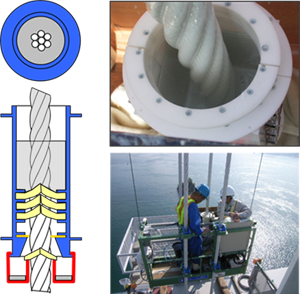
Immersion painting method
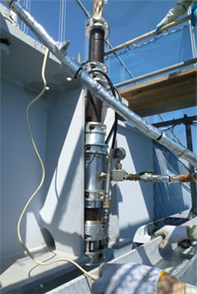
Internal-fill method











